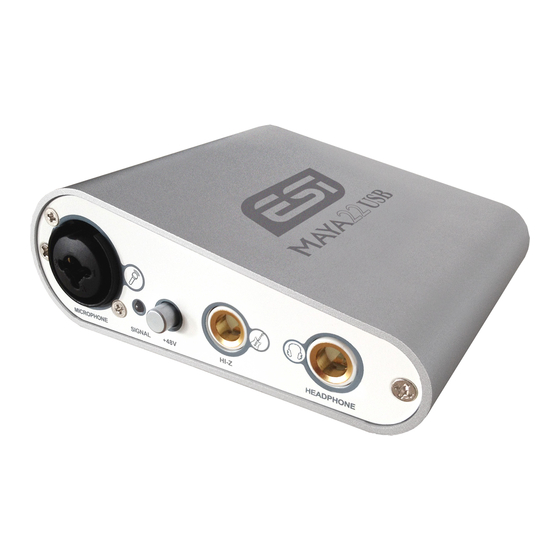ESI MAYA22 USB Руководство пользователя - Страница 10
Просмотреть онлайн или скачать pdf Руководство пользователя для Оборудование для звукозаписи ESI MAYA22 USB. ESI MAYA22 USB 14 страниц. Flexible high performance 24-bit usb audio interface

ESI
MAYA22 USB
3.3 Latency settings
Via Config > Latency in the Control Panel it is possible to change the latency setting (also called
"buffer size") for the driver of MAYA22 USB. A smaller latency is the result of a smaller buffer
size. Depending on the typical application (e.g. for playback of software synthesizers) a smaller
latency is an advantage. At the same time, the best latency setting indirectly depends on the
performance of your system. For recording applications, a typical latency buffer size between 4 and
8ms is standard. Note that the latency has to be setup before launching the audio application using
MAYA22 USB.
3.3 DirectWIRE
What is DirectWIRE?
DirectWIRE is a driver technology, developed by ESI, which can be used for routing audio streams
internally within applications using EWDM Audio MIDI Drivers exclusively developed by ESI.
With the DirectWIRE router, an application can record from other application's audio outputs
without external wiring or any loss of data when they are running at the same time.
DirectWIRE also allows you to easily rip any audio stream in real time by transferring data thru
DirectWIRE from MP3s, live On-line Broadcast and On-demand content, and more.
DirectWIRE is not available under Mac OS X.
DirectWIRE Panel
Click on DirectWIRE on the MAYA22 USB control panel. The DirectWIRE dialog as shown below
will appear. DirectWIRE digital virtual wiring technology, developed by ESI, routes audio streams
internally within applications using standard audio drivers such as WDM, ASIO and MME, even
when they are running at the same time.
The number on the row represents the input or output port. The columns represent ins and outs (on
and off) of the respected drivers. Patch the virtual cables from one point to another as you drag your
mouse point.
INPUT section: It's used to route signals from the card's hardware inputs.
MME section represents general application's I/O: Ex.) WinAmp, WaveLab (non ASIO mode),
Cakewalk, Audition, Vegas, etc.
WDM section represents Multi-MME application's I/O: Ex.) SONAR (when using WDM/KS),
PowerDVD, WinDVD, etc.
10
